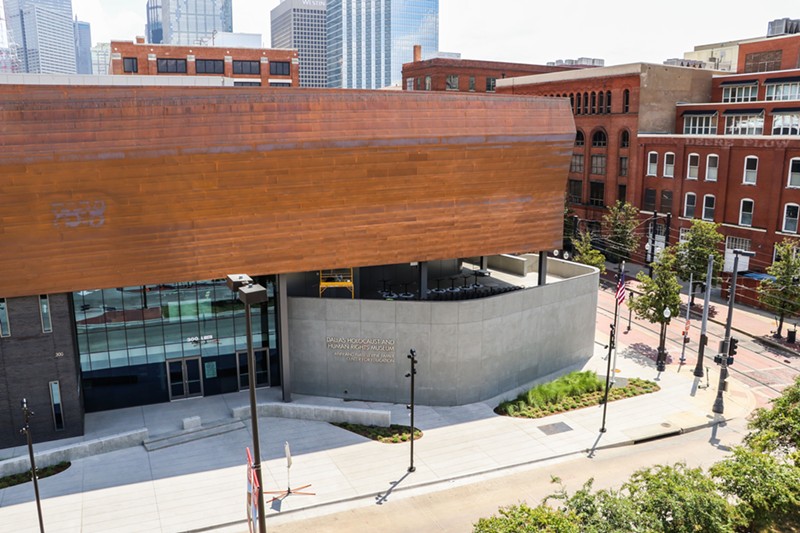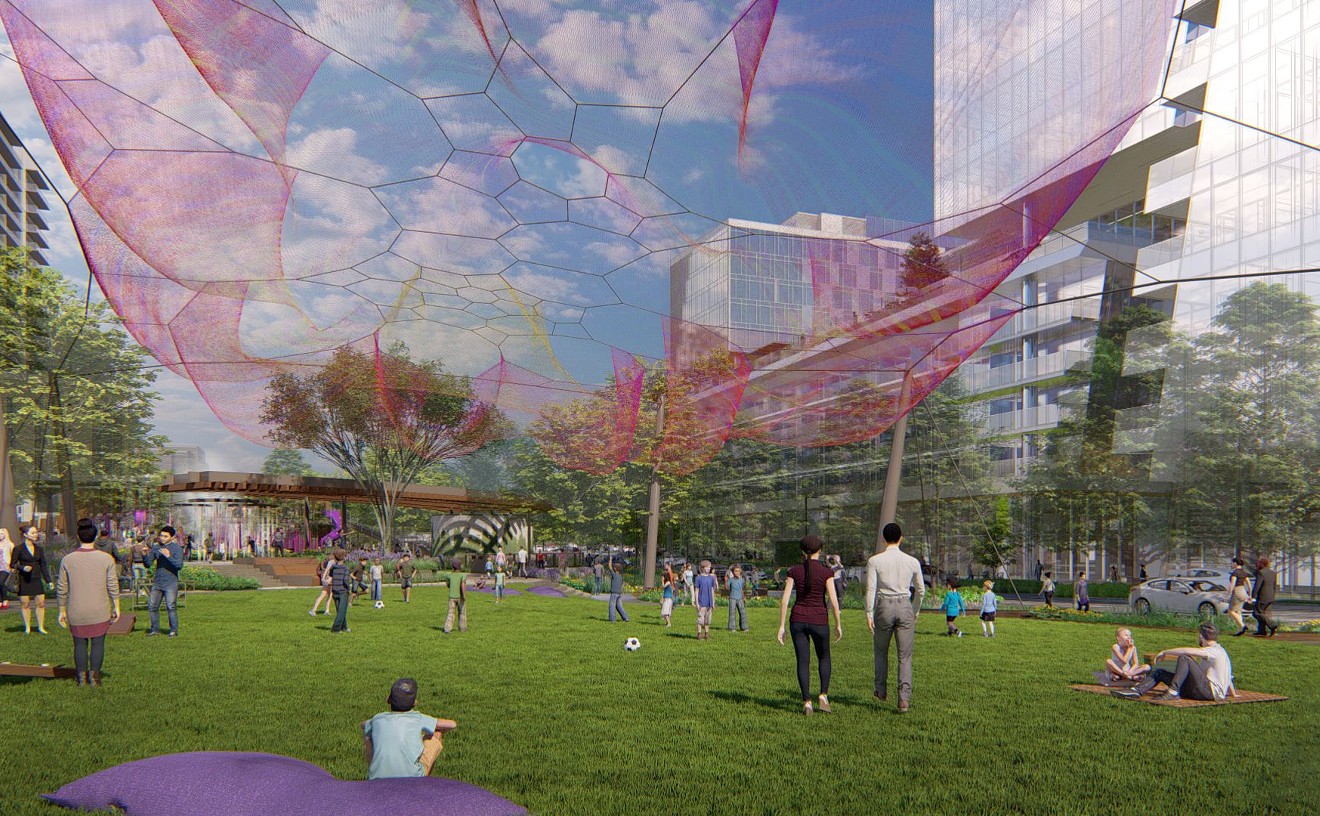The 55,000-square-foot building will open to the public on Sept. 18, on 300 N. Houston St. On Sept. 17, the day before the opening, there will be a ribbon-cutting ceremony and open house with remarks by Texas Gov. Greg Abbott and Dallas Mayor Eric Johnson.
The new venue will accommodate over 200,000 annual visitors, a stark contrast with the 87,000 that the West End facilities hosted. While there are 21 Holocaust-related museums in the nation, the brand-new Dallas Holocaust and Human Rights Museum stands out for the state-of-the-art, immersive technology used in its exhibitions — also because it takes an in-depth look at human rights, genocides that have taken place in other countries and the history of civil rights in America.
The museum’s mission is “to teach the history of the Holocaust and to advance human rights to combat prejudice, hatred, and indifference.” One would have thought that by now, well into the 21st century, we would've overcome the need for modern Horsemen of the Apocalypse. Sadly, current events show that there is still a need for the educational and cultural programs that the museum provides. The aim is to sensitize and empower the community so that it can respond positively in the face of today’s moral and ethical issues.
The museum’s three floors will house four wings: Orientation, Shoah/Holocaust, Human Rights and Pivot to America. The tour starts in the Orientation Wing on the first floor. Visitors will be shown a video with scenes from recent world events, paired with fundamental questions like “Why should I care about the Holocaust?” or “What can I do to make a difference?”
Upon exiting the theater, and while visitors mull the answers to these questions, they will learn about the history of the Jewish people and what their life was like before World War II through photos of local survivors. The second floor houses the state-of-the-art, interactive Dimensions in Testimony SM Theater, created by the University of Southern California's Shoah Foundation. This initiative preserves the testimonies of Holocaust and genocide survivors. Thanks to the interactive aspect of this proprietary video capture process, visitors will be able to ask Texas Holocaust survivor Max Glauben, 91, questions about his life before, during and after World War II. High-definition holographic interview recordings and voice recognition technology will enable a sort of one-on-one virtual conversation.
Glauben answered almost 1,000 questions about his life, about surviving the Warsaw Ghetto, five concentration camps and a death march before Gen. George S. Patton’s 3rd Army tank division liberated him and those with him. Glauben was marked spiritually by these harrowing experiences, as well as physically with a tattoo reading "KL," which designated him as a camp prisoner.
“This is my greatest reward in my lifetime,” he said of the holographic technology, “to tell people about what has happened so they could respect the rights of other people and not allow another holocaust to happen.”
The tour continues on the third floor, in the Holocaust/Shoah Wing. But what does the word "holocaust" mean? In its Greek origins, it referred to a sacrificial offering burned on an altar. However, the use of the word changed radically in 1945, when it took on a different meaning: the planned and systematic mass murder of about 6 million European Jews, as well as other ethnic minorities and homosexuals, perpetrated by the Nazi regime during World War II (1939-1945). 'Shoah' is Hebrew for "catastrophe."
The wing is organized geographically, as well as chronologically. Floor maps show the reach of the German Army during the war, or the locations of ghettos, concentration and death camps across Europe. The Germany section of the exhibition provides an insight into Hitler’s repugnant and twisted worldview that led to the Holocaust, and includes quotes from his writings. The wing also features a replica of the Brandenburg Gate, strewn with German flags and swastikas. The Brandenburg Gate was the background of Hitler’s propaganda events, and it situates visitors in time and place: Berlin at the zenith of Nazi Germany.“This is my greatest reward in my lifetime, to tell people about what has happened so they could respect the rights of other people and not allow another holocaust to happen.” — Holocaust survivor Max Glauben
tweet this
The Poland section tells of life in the Jewish ghettos and the Warsaw Ghetto Uprising of 1943, an unsuccessful armed revolt staged to prevent deportations to death camps. Visitors will find the Killing Center through an original boxcar, acquired by local survivors in 1984 and carefully restored. Boxcars were used to transport Jews to the concentration and death camps. Video testimonies describe the horrors of riding railroad cars during the war.
In the Killing Center, a number of suitcases suspended from the ceiling represent the deportation process and the terror and chaos it caused. On the walls, the six killing centers, like Auschwitz or Treblinka, are explained. The Liberation section is devoted to the events of 1944-45, when Allied forces liberated the concentration camps. It juxtaposes the sheer joy of liberated Europe with the bittersweet victory felt by camp survivors.
The tour segues into the next wing, the Human Rights Wing, which shows how the world dealt with the Holocaust and its aftermath; the need to document those events; and how to prevent a tragedy of that magnitude from happening again.
The Nuremberg Trials Gallery explores what happened from Nov. 20, 1945 and onward, when Nazi leaders were put on trial and charged with crimes against humanity, war crimes and crimes against peace. The International Military Tribunal in charge of the trials was composed of a judge and a prosecution team supplied by each of the four Allied nations (the United States, Great Britain, the former Soviet Union and France).
The centerpiece of the Human Rights exhibition is the replica of a Greek portico, said to have inspired jurist, judge and Nobel Peace Prize laureate René Cassin to structure the Universal Declaration of Human Rights. In his words, “‘there will never be peace on this planet as long as human rights are being violated in any part of the world.” Cassin co-drafted the document with Eleanor Roosevelt, also featured in the exhibition. They based the Declaration on four pillars: dignity, liberty, equality and brotherhood.
The Genocide Gallery educates visitors on how genocide begins and how to prevent it, and to identify early warning signs. This section explains the events of 10 genocides, like Cambodia or Rwanda's, through graphic novels and sculptures. It also highlights Stanton’s Ten Stages of Genocide model: classification, symbolization, discrimination, dehumanization, organization, polarization, preparation, persecution, extermination and denial.
The exhibition transitions into the Pivot to America Wing. Its gateway showcases the nation’s foundational documents and their relevance in today’s world. The main exhibition features four immersive, interactive media stations that focus on major American history events, from slavery to the Native American experience, Latino and Tejano history, the Civil Rights Movement, the history of women’s rights, LGBTQ rights and racism.
At the Beyond Tolerance Theater, visitors will be able to explore their own attitudes and biases. And, hopefully, be inspired to stand up against justice and intolerance. The Call to Action Gallery will encourage visitors to become Upstanders: individuals who refuse to accept the status quo and inspire others with a call to action. Here, visitors will learn about individuals and organizations like Martin Luther King Jr., Mother Teresa or Malala Yousafzai, who have called attention to evil, or alleviated suffering.
At the Reflection and Memorial Room, visitors will have the opportunity to reflect about the exhibition, its impact on them, the thoughts or feelings raised during their visit and what they can do to become Upstanders.
As Michael S. Rawlings, the 61st Mayor of Dallas, said: “We need a place that allows us to have a discussion about what human rights, what diversity, what respect for others mean for our city today. The new Dallas Holocaust and Human Rights Museum is the right starting point for that discussion."












